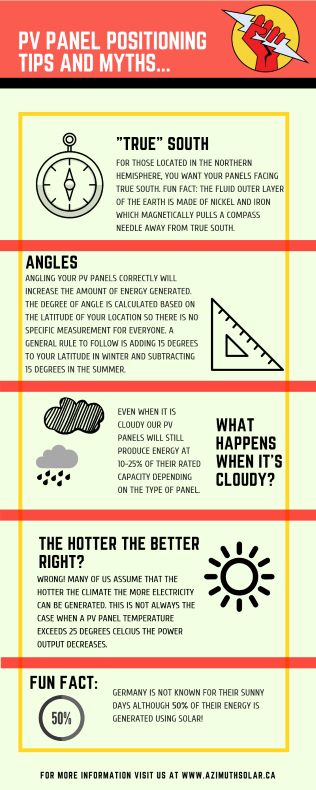Whether you have already converted to solar power or you are considering the switch, it is important to understand the best positioning and angling of your photovoltaic (PV) panels to generate the highest levels of power. Orienting your PV panels correctly varies with different locations around the world and is essential to getting the most out of the sun’s power to meet your solar energy needs. This blog post will provide valuable orientation tips as well as some insight towards the topic of solar panels and their ability to produce electricity on cloudy days.
Optimum Positioning and Angling for your PV Panels
Purchasing a solar power system is a worthwhile investment, and like any investment you will want to ensure you get the most out of it – installing your PV panels in the optimal position based on your location is the best way to reap the full benefits of your solar system! In the Northern Hemisphere it is recommended to face your PV panels toward “true” south as this provides the best direct exposure.
FUN FACT: There is a difference between true south and regular south (magnetic). The earth has a fluid outer core made up of nickel and iron which creates a magnetic pull that slightly moves a compass needle away from true south.
In a perfect world, adjusting your PV panels throughout the day to follow the sun’s movements would provide the ultimate sun exposure; however, as I am sure you are already thinking that is not at all practical unless you invest in a solar tracker. Solar trackers are an innovative piece of technology, but do your research first, as often they require excessive power and expense, which can negate the initial benefits of install. For panels fixed to a mount that allow you to tilt back and forth, whether placed on a roof or on the ground, here are some general guidelines for the best angling. Angling your PV panels is different everywhere as the calculation is based on your location’s specific latitude, and depends on the season. In the summer months you will want to subtract 15 degrees from your locations latitude and in the winter months you will add 15 degrees and angle the panels accordingly. As mentioned this is an approximate guideline and for more accurate calculations you can consult a professional upon installation or visit the Solar Electricity Handbook website that provides a helpful online solar angle calculator!
Will my solar panels generate power on cloudy days?
Thinking about going solar but you don’t live in a sunny place? Most people tend to think that if they do not live in a hot and sunny location there is no use investing in a solar power system. However, this is not always the case, as solar panels can still produce 10-25% of their rated energy capacity on a cloudy day. PV panels can still capture both visible light and infrared light on even the cloudiest and gray days which is then generated into electricity, just as it would be on a sunny day. Visible light is the light we can see every day and infrared light we cannot see; although, it can penetrate clouds easier than visible light due to its longer wave lengths. So, if I haven’t yet convinced you of PV panels ability to generate power on cloudy days here is a prime example of solar working at its best in a place not usually known for its sunshine. Germany, a leader in the world of solar energy does not experience sunshine like other parts of the world yet 50% of its electricity is generated with the use of solar power systems! It is further north than most of the populated areas of Canada! While some of the world’s hotter locations are well suited for generating solar power, a common misconception is that hotter is better. Keep in mind that the temperature of your PV panels is important because if it exceeds 25 C the power output efficiency will decrease due to increased internal resistance. Your solar panels can produce more power on a cold sunny winter day, than a hot summer day! In the far north, “the Land of the Midnight Sun”, summer days have up to 24 hours of sunlight. For seasonal work and activity, solar power is very well-suited for this region, where fuel is expensive to transport.
In relation to a “grid tied” solar power system the concern of generating enough energy on a cloudy day can be lessened due to the fact your local utility grid will supplement your power supply during the evening and when the weather is not in your favour. When it comes to an off grid solar system, power conservation when the weather is not behaving becomes a little more pertinent; however, most system set ups will include a battery bank to store solar energy for use in the evening or those times when it is cloudy, and irradiance is low. It is important to gauge your energy consumption and take local weather conditions into consideration when sizing your solar system and battery storage. It is usually recommended to have battery storage capacity for 2-3 days power consumption.
Understanding correct angling and positioning will allow you to optimize your PV panels to harness solar energy to the fullest and get the most out of your investment! If you are still considering whether to go solar be sure to do your research regarding your location and remember just because it is cloudy doesn’t mean you can’t generate solar power. Be sure to check out the helpful infographic we have included for a quick guide to helpful tips to optimizing your PV panels!
Blog by Victoria Rump
To help optimize your panels, you can use an adjustable angle mounting bracket for your panels.

